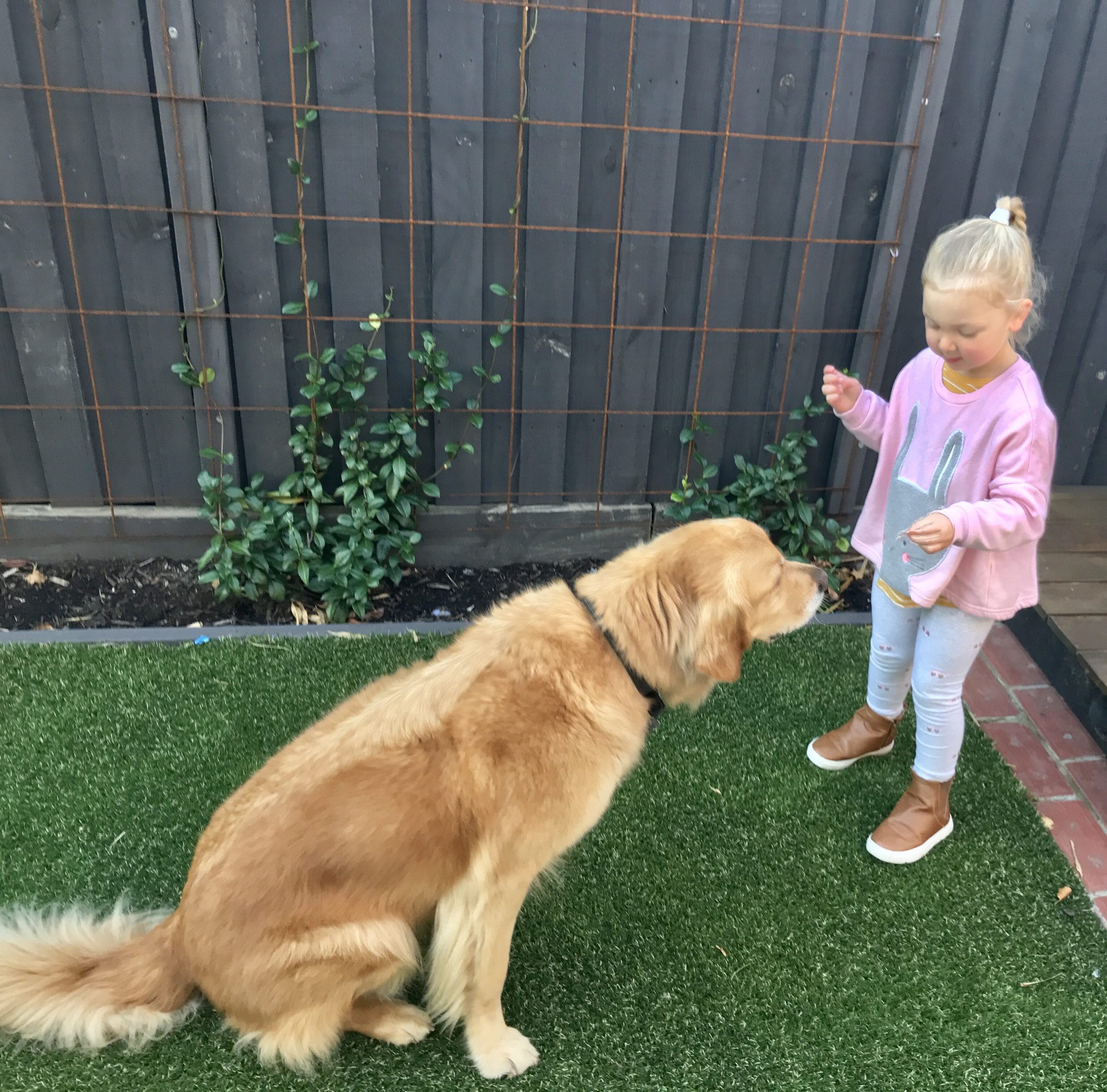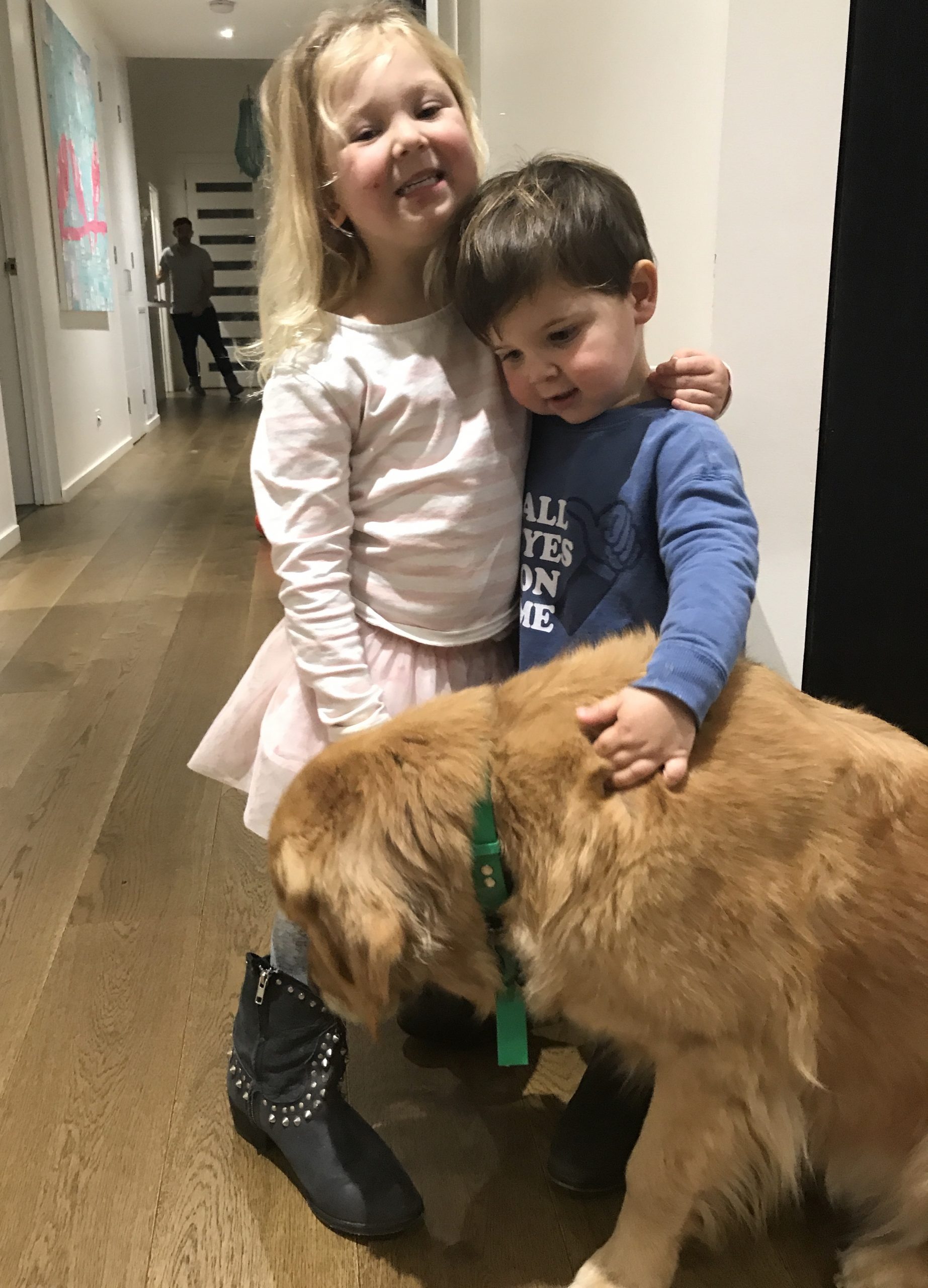Dog bites to children are far too common. So let’s teach our children how to be safe around dogs. Dog bites occur when dogs feel threatened, frightened, or defensive. Space is important to dogs. When they feel cornered they are more likely to bite. Understanding dog body language is the single best tool for eliminating dog bites. The perception is sometimes that a dog “bit without warning,” but the reality is usually that the people did not understand the dog’s warning or take the necessary measures to resolve the situation peacefully.
So, in saying all of this, it’s so important as parents that we teach our kids these three steps for meeting a dog safely. Our children copy our every move too so it’s important that you model these steps and show them how it’s done. These steps can also be applied to your own family dog…
Three steps to Teach your child how to safely say hello to dogs
STEP 1: Always Ask the Owner first
It’s very important to teach kids how to interact with dogs they are interested in and to not just run up to them. Childish excitement could be interpreted as a threat by inexperienced dogs.
Teach kids not to rush toward a dog. Encourage them to stop about 3 steps away and ask the owner, “May I pat your dog?” Sometimes the answer will be no. Many dogs don’t live with kids and are not comfortable with them. So if the dog’s owner says no, that’s okay. In fact, good on them, for standing up for their dog and being their advocate. This owner is just protecting you and protecting their dog who might not enjoy being patted by children or strangers. Remind your child that there are lots of other dogs who would love to be patted by them but this dog just doesn’t feel like a pat right now. You could suggest that they wave to the dog or blow a kiss instead.
If the owner says yes, then the children must ask the dog.
Please teach your child that if there is no owner in site, they should never pat the dog. For example if the dog is tied up to the fence outside school or at the supermarket, you must leave them alone. A dog who is tied up without their owner in site, might be feeling stressed, scared or anxious. They have no way to escape the situation if a stranger approached them and they are feeling uncomfortable. so they could react with a bite.
 STEP 2: Always ask the Dog
STEP 2: Always ask the Dog
Do Not Skip This Step! Tell kids that dogs don’t use words but instead rely on body language. So we are going to ask the dog and see what his body language tells us…
Ask your child to tap their leg and call the dogs name in a happy high pitch voice… They don’t need to stick their hand in the dogs face to get them to sniff it – this can actually be dangerous as some dogs will find it scary and might react. Dogs have a great sense of smell so can already smell your child from where they are. Rather we want to encourage them in.
Also direct eye contact can be scary for some dogs. I like to encourage a dog in, whilst standing side on and not making direct eye contact – if the child is old enough, please make sure to teach this to them too.
When the dog is being given the option to approach, watch his body language.
- Does he come forward with loose, waggy motions? That’s definitely a yes.
- Does he lean forward for a quick sniff and seem comfortable? Also a yes.
- Does he turn his face away from your child’s hand? Back away? Bark? Move behind the owner? Look anxious and unsettled? Growl? These are all no’s.
Unfortunately some owners don’t understand or respect their dog’s decision and will drag the dog forward saying, “Oh, he’s fine. He loves kids. You can pat him.” DON’T! Do not ever allow children to pet a dog that does not approach them willingly. If we approach an anxious or nervous dog, especially if they are on lead and cannot escape, they could react out of fear. So please don’t put your child in that situation.
To some dogs, children can be quite scary. So it is really important that we give the dog a choice.
If it’s your own dog that your child would like to pat, your child should also ask the dog for permission first before approaching.

STEP 3: How to Pat the Dog
If the owner said yes and the dog said yes, the kids can pat the dog. Tell the kids that they need to be careful of a dog’s sensitive eyes and ears. Most dogs don’t like to be patted on top of their heads, but nearly all people do it —it’s a hardwired human behaviour. There is a blind spot on top of a dog’s head. If he sees a child’s hand moving toward that area, the natural inclination is for him to tilt his head up and watch where the hand is going. Now the child’s hand is reaching right over the dog’s teeth—not a very good place for that hand to be. Suggest that the children stroke the side of the dog’s neck, rub under his chin, scratch his chest, or pat along his back. Most dogs prefer slow, gentle strokes to rapid pat-pat-patting. Alternatively your child can ask the owner if the dog has a favourite spot to be patted. Let your child pat the dog for 3 seconds and stop. If the dog’s had enough it will move away, shake off or turn its head. If the dog wants more, your child can continue to pat. At Family Paws, we say ‘one hand enough… two hands too rough’.

You might not know this but a dog will always communicate if they are feeling stressed in a situation before reacting with a bite. So it is up to you to recognise their signs, and intervene before it’s too late. We don’t ever want to put a dog in a situation where they feel they need to bite a child to escape. If we listen and respond to their subtle signs of communication, we can avoid situations like dog bites happening.
For more info on child and dog safety and how dogs communicate make sure to have a read of these articles:
- How Dogs Communicate
- Our Dogs Are Always Communicating Let’s Learn To Understand Them And Help Prevent Dog Bites To Children
- Good Intentions Aren’t Enough. We Want Dogs To Enjoy Their Encounters With Children Rather Than Just Tolerating Them.
- Teach your child to interact safely with dogs and know the warning signs to look for
- Five Important Skills to teach your Dog when Around Young Children
- Lead by example to show your child how to interact safely with dogs
- Managing your Dog when having Visitors and Children Coming Over
As always if you have any questions on this topic, please get in touch.
Mel xox
PS. Make sure to head to our SHOP if you haven’t already! Spoil yourself and your dog!!


